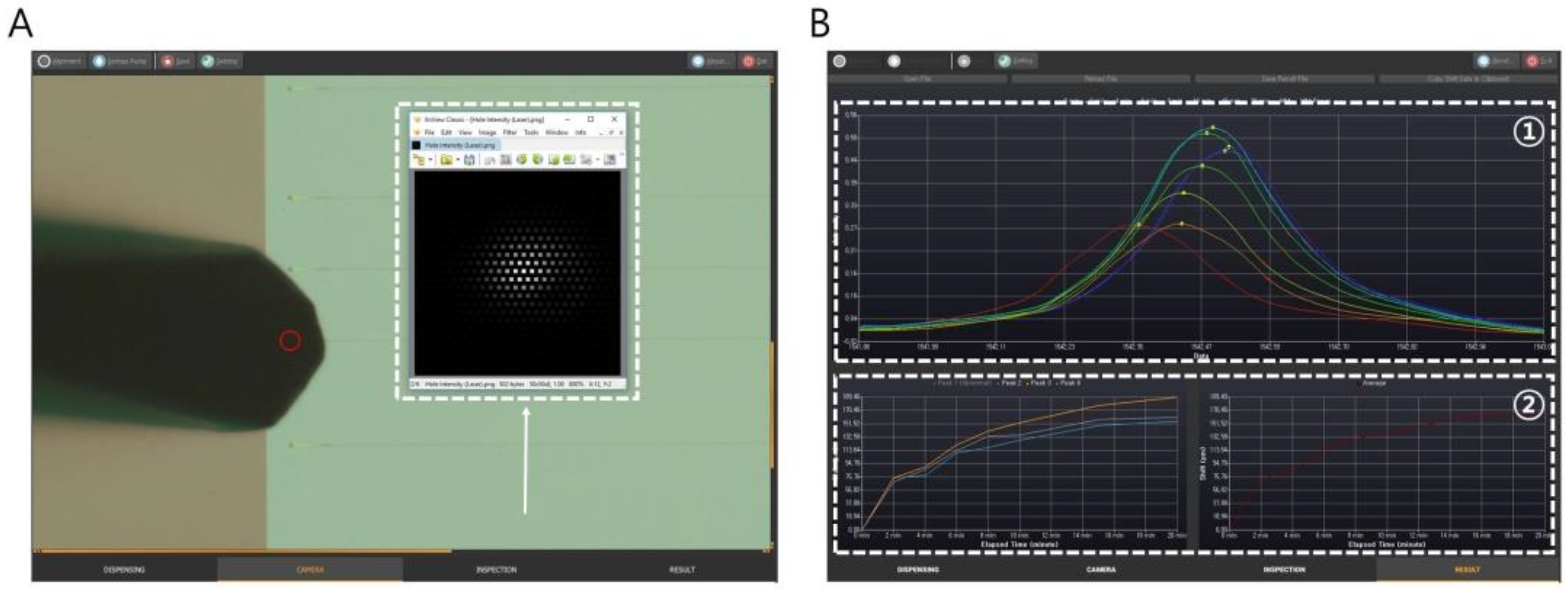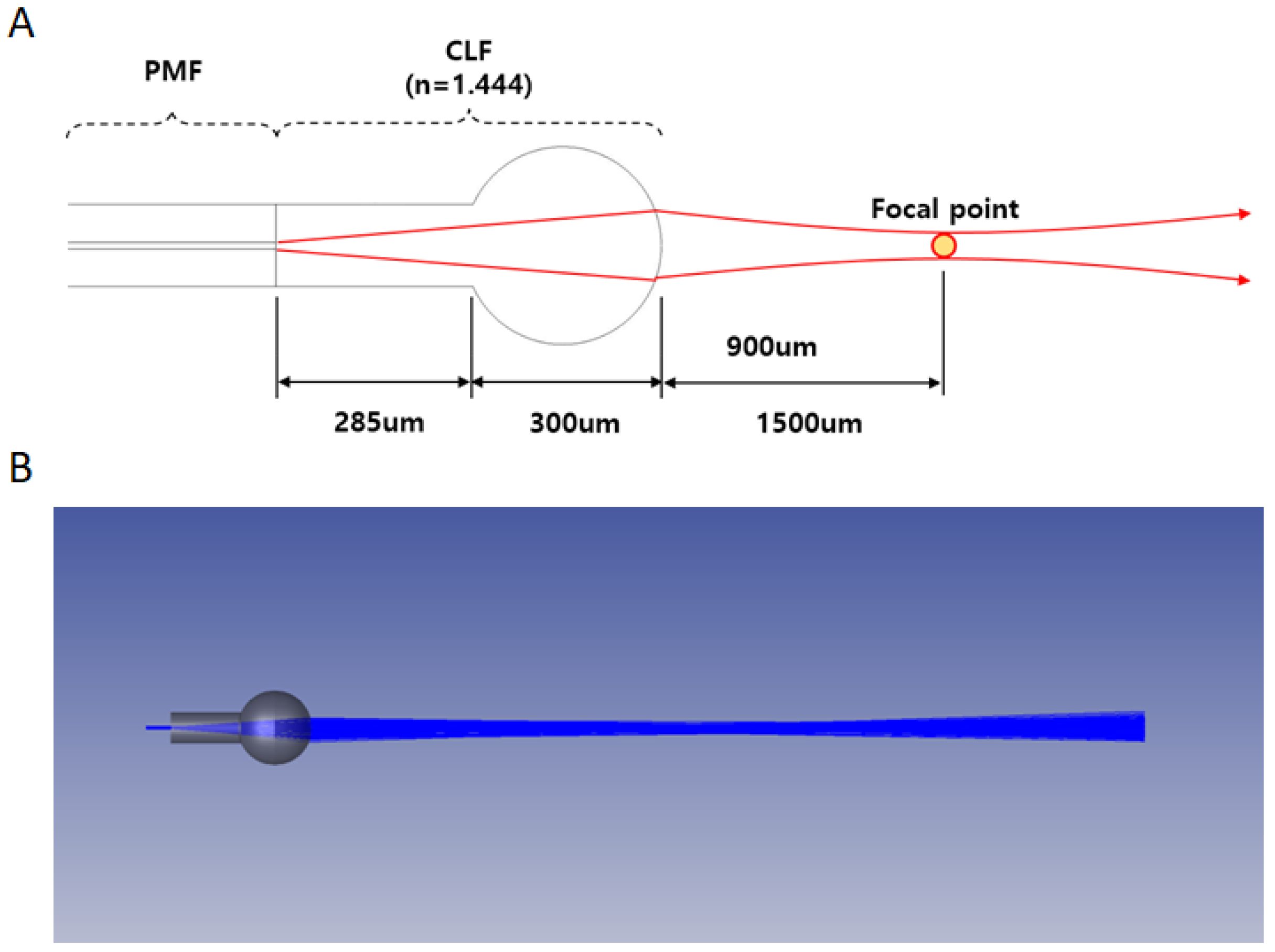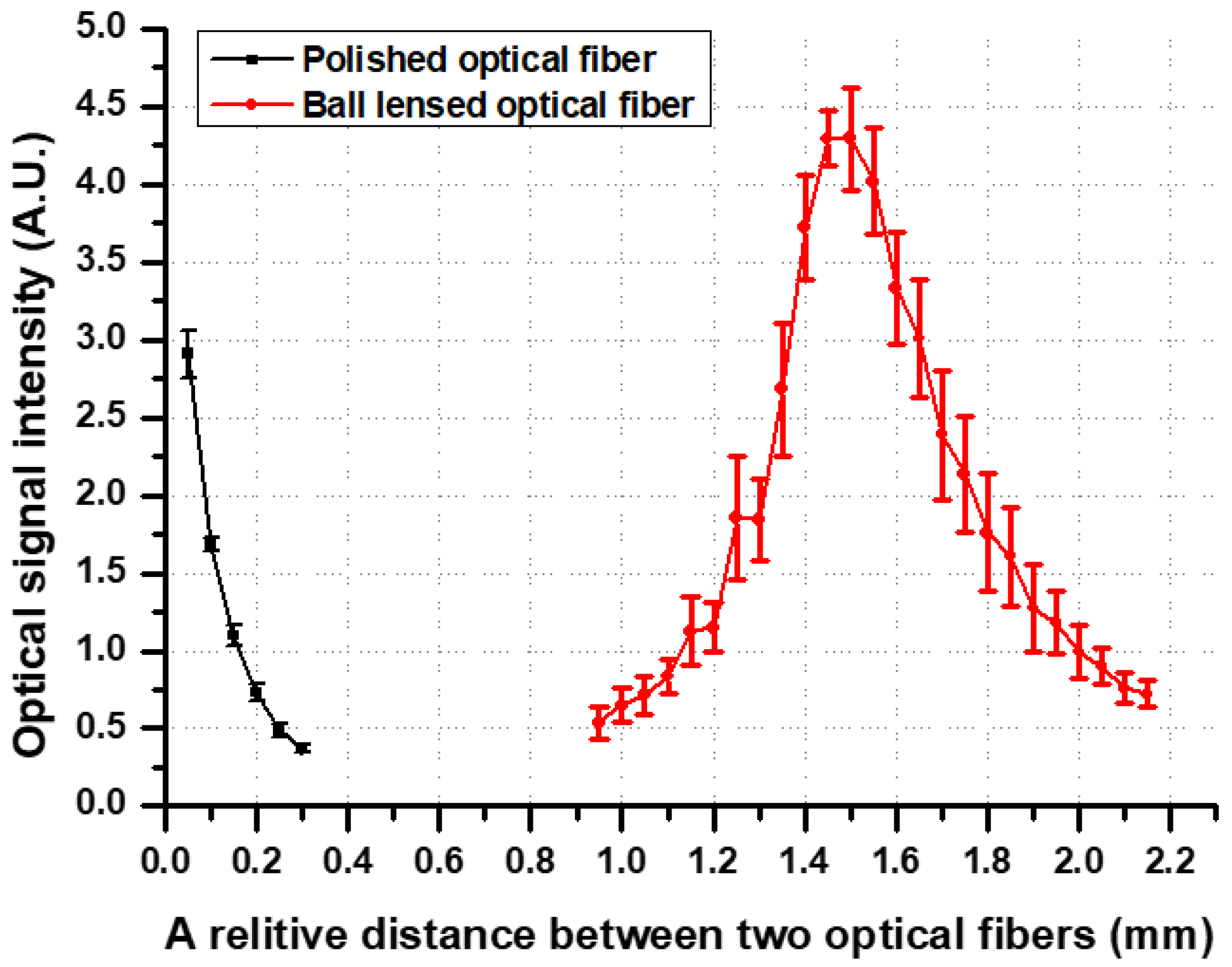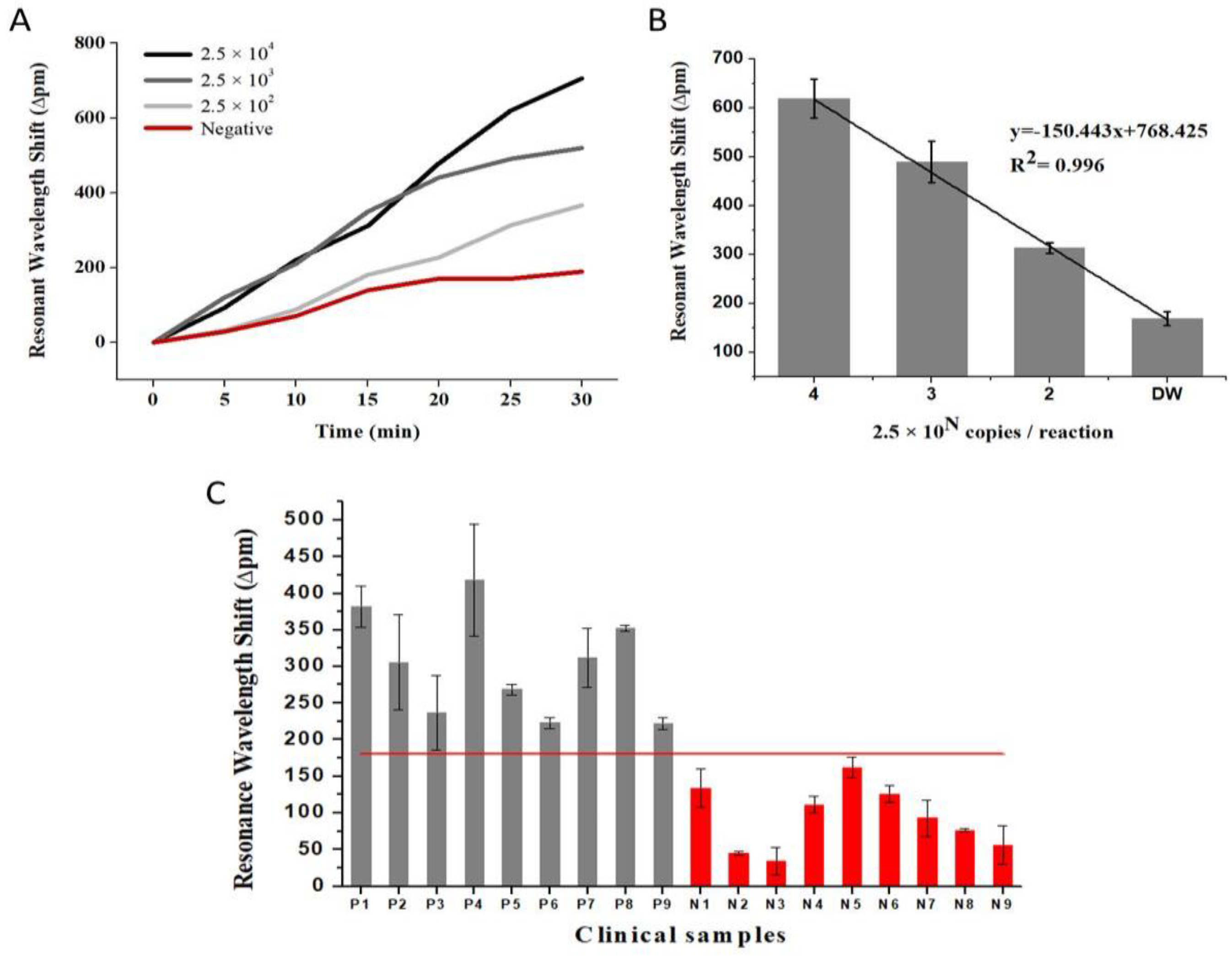Rapid Molecular Diagnostic Sensor Based on Ball-Lensed Optical Fibers
Abstract
1. Introduction
2. Materials and Methods
2.1. BLOF Based Optical Bio-Signal Measurement System
2.2. Signal Detection with the BLOF-Based Bio-Optical Sensor
2.3. Automatic Analysis of Detection of the Resonant Wavelength Shift in a Given Time
2.4. Amplification of Coxiella Burnetii DNA on the BLOF Based Bio-Optical Sensor
3. Results
3.1. Design and Manufacture of the Ball-Lensed Optical Fibers (BLOFs)
3.2. Characterization of the Ball-Lensed Optical Fibers (BLOFs)
3.3. Clinical Diagnosis of Q Fever Using the BLOF Based Sensor
4. Conclusions
Supplementary Materials
Author Contributions
Funding
Institutional Review Board Statement
Informed Consent Statement
Data Availability Statement
Conflicts of Interest
References
- Karesh, W.B.; Dobson, A.; Lloyd-Smith, J.O.; Lubroth, J.; Dixon, M.A.; Bennett, M.; Aldrich, S.; Harrington, T.; Formenty, P.; Loh, E.H.; et al. Ecology of zoonoses: Natural and unnatural histories. Lancet 2012, 380, 1936–1945. [Google Scholar] [CrossRef]
- McMichael, A.J. Globalization, Climate Change, and Human Health. N. Engl. J. Med. 2013, 368, 1335–1343. [Google Scholar] [CrossRef]
- Semenza, J.C.; Menne, B. Climate change and infectious diseases in Europe. Lancet Infect. Dis. 2009, 9, 365–375. [Google Scholar] [CrossRef]
- Bloom, D.E.; Black, S.; Rappuoli, R. Emerging infectious diseases: A proactive approach. Proc. Natl. Acad. Sci. USA 2017, 114, 4055–4059. [Google Scholar] [CrossRef] [PubMed]
- McCloskey, B.; Dar, O.; Zumla, A.; Heymann, D.L. Emerging infectious diseases and pandemic potential: Status quo and reducing risk of global spread. Lancet Infect. Dis. 2014, 14, 1001–1010. [Google Scholar] [CrossRef]
- Zhu, N.; Zhang, D.; Wang, W.; Li, X.; Yang, B.; Song, J.; Zhao, X.; Huang, B.; Shi, W.; Lu, R.; et al. A Novel Coronavirus from Patients with Pneumonia in China, 2019. N. Engl. J. Med. 2020, 382, 727–733. [Google Scholar] [CrossRef] [PubMed]
- Long, C.; Xu, H.; Shen, Q.; Zhang, X.; Fan, B.; Wang, C.; Zeng, B.; Li, Z.; Li, X.; Li, H. Diagnosis of the Coronavirus disease (COVID-19): rRT-PCR or CT? Eur. J. Radiol. 2020, 126, 108961. [Google Scholar] [CrossRef] [PubMed]
- Yang, S.; Rothman, R.E. PCR-Based Diagnostics for Infectious Diseases: Uses, Limitations, and Future Applications in Acute-Care Settings. Lancet Infect. Dis. 2004, 4, 337–348. [Google Scholar] [CrossRef]
- Peeling, R.W.; Mabey, D. Point-of-care tests for diagnosing infections in the developing world. Clin. Microbiol. Infect. 2010, 16, 1062–1069. [Google Scholar] [CrossRef]
- Yoo, S.M.; Lee, S.Y. Optical Biosensors for the Detection of Pathogenic Microorganisms. Trends Biotechnol. 2016, 34, 7–25. [Google Scholar] [CrossRef]
- Kuswandi, B.; Nuriman; Huskens, J.; Verboom, W. Optical sensing systems for microfluidic devices: A review. Anal. Chim. Acta 2007, 601, 141–155. [Google Scholar] [CrossRef] [PubMed]
- Pires, N.M.M.; Dong, T.; Hanke, U.; Hoivik, N. Recent developments in optical detection technologies in lab-on-a-chip devices for biosensing applications. Sensors 2014, 14, 15458–15479. [Google Scholar] [CrossRef] [PubMed]
- Barozzi, M.; Manicardi, A.; Vannucci, A.; Candiani, A.; Sozzi, M.; Konstantaki, M.; Pissadakis, S.; Corradini, R.; Selleri, S.; Cucinotta, A. Optical Fiber Sensors for Label-Free DNA Detection. J. Light. Technol. 2017, 35, 3461–3472. [Google Scholar] [CrossRef]
- Cennamo, N.; Varriale, A.; Pennacchio, A.; Staiano, M.; Massarotti, D.; Zeni, L.; DAuria, S. An innovative plastic optical fiber-based biosensor for new bio/applications. the case of celiac disease. Sens. Actuators B Chem. 2013, 176, 1008–1014. [Google Scholar] [CrossRef]
- Chen, Q.; Huang, F.; Cai, G.; Wang, M.; Lin, J. An optical biosensor using immunomagnetic separation, urease catalysis and pH indication for rapid and sensitive detection of Listeria monocytogenes. Sens. Actuators B Chem. 2018, 258, 447–453. [Google Scholar] [CrossRef]
- Ramakrishnan, M.; Rajan, G.; Semenova, Y.; Farrell, G. Overview of fiber optic sensor technologies for strain/temperature sensing applications in composite materials. Sensors 2016, 16, 99. [Google Scholar] [CrossRef] [PubMed]
- Hu, J.; Wang, S.Q.; Wang, L.; Li, F.; Pingguan-Murphy, B.; Lu, T.J.; Xu, F. Advances in paper-based point-of-care diagnostics. Biosens. Bioelectron. 2014, 54, 585–597. [Google Scholar] [CrossRef]
- Foudeh, A.M.; Didar, T.F.; Veres, T.; Tabrizian, M. Microfluidic Designs and Techniques Using Lab-on-a-Chip Devices for Pathogen Detection for Point-of-Care Diagnostics. Lab Chip 2012, 12, 3249–3266. [Google Scholar] [CrossRef]
- Yetisen, A.K.; Akram, M.S.; Lowe, C.R. Paper-based microfluidic point-of-care diagnostic devices. Lab Chip 2013, 13, 2210–2251. [Google Scholar] [CrossRef]
- Kim, J.Y.; Koo, B.; Jin, C.E.; Kim, M.C.; Chong, Y.P.; Lee, S.-O.; Choi, S.-H.; Kim, Y.S.; Woo, J.H.; Shin, Y.; et al. Rapid diagnosis of tick-borne illnesses by use of one-step isothermal nucleic acid amplification and bio-optical sensor detection. Clin. Chem. 2018, 64, 556–565. [Google Scholar] [CrossRef]
- Koo, B.; Jin, C.E.; Lee, T.Y.; Lee, J.H.; Park, M.K.; Sung, H.; Park, S.Y.; Lee, H.J.; Kim, S.M.; Kim, J.Y.; et al. An isothermal, label-free, and rapid one-step RNA amplification/detection assay for diagnosis of respiratory viral infections. Biosens. Bioelectron. 2017, 90, 187–194. [Google Scholar] [CrossRef]
- Koo, B.; Hong, K.H.; Jin, C.E.; Kim, J.Y.; Kim, S.H.; Shin, Y. Arch-shaped multiple-target sensing for rapid diagnosis and identification of emerging infectious pathogens. Biosens. Bioelectron. 2018, 119, 79–85. [Google Scholar] [CrossRef]
- Koo, B.; Jin, C.E.; Park, S.Y.; Lee, T.Y.; Nam, J.; Jang, Y.R.; Kim, S.M.; Kim, J.Y.; Kim, S.H.; Shin, Y. A rapid bio-optical sensor for diagnosing Q fever in clinical specimens. J. Biophotonics 2018, 11, 1–9. [Google Scholar] [CrossRef]
- Koo, B.; Jin, C.E.; Bae, M.; Jang, Y.O.; Kim, J.Y.; Kim, S.H.; Shin, Y. Detection of Coxiella burnetii using silicon microring resonator in patient blood plasma. Micromachines 2019, 10, 427. [Google Scholar] [CrossRef] [PubMed]
- Park, B.J.; Lee, S.R.; Bang, H.J.; Kim, B.Y.; Park, J.H.; Kim, D.G.; Park, S.S.; Won, Y.J. Image-guided laparoscopic surgical tool (IGLaST) based on the optical frequency domain imaging (OFDI) to prevent bleeding. Sensors 2017, 17, 919. [Google Scholar] [CrossRef] [PubMed]
- Tan, K.M.; Shishkov, M.; Chee, A.; Applegate, M.B.; Bouma, B.E.; Suter, M.J. Flexible transbronchial optical frequency domain imaging smart needle for biopsy guidance. Biomed. Opt. Express 2012, 3, 1947–1954. [Google Scholar] [CrossRef]
- Bae, M.; Jin, C.E.; Park, J.H.; Kim, M.J.; Chong, Y.P.; Lee, S.O.; Choi, S.H.; Kim, Y.S.; Woo, J.H.; Shin, Y.; et al. Diagnostic usefulness of molecular detection of Coxiella burnetii from blood of patients with suspected acute Q fever. Medicine 2019, 98, e15724. [Google Scholar] [CrossRef] [PubMed]






Publisher’s Note: MDPI stays neutral with regard to jurisdictional claims in published maps and institutional affiliations. |
© 2021 by the authors. Licensee MDPI, Basel, Switzerland. This article is an open access article distributed under the terms and conditions of the Creative Commons Attribution (CC BY) license (https://creativecommons.org/licenses/by/4.0/).
Share and Cite
Park, B.; Koo, B.; Kim, J.; Lee, K.; Bang, H.; Kim, S.-H.; Jhang, K.Y.; Shin, Y.; Lee, S. Rapid Molecular Diagnostic Sensor Based on Ball-Lensed Optical Fibers. Biosensors 2021, 11, 125. https://doi.org/10.3390/bios11040125
Park B, Koo B, Kim J, Lee K, Bang H, Kim S-H, Jhang KY, Shin Y, Lee S. Rapid Molecular Diagnostic Sensor Based on Ball-Lensed Optical Fibers. Biosensors. 2021; 11(4):125. https://doi.org/10.3390/bios11040125
Chicago/Turabian StylePark, Byungjun, Bonhan Koo, Jisub Kim, Kiri Lee, Hyeonjin Bang, Sung-Han Kim, Kyung Young Jhang, Yong Shin, and Seungrag Lee. 2021. "Rapid Molecular Diagnostic Sensor Based on Ball-Lensed Optical Fibers" Biosensors 11, no. 4: 125. https://doi.org/10.3390/bios11040125
APA StylePark, B., Koo, B., Kim, J., Lee, K., Bang, H., Kim, S.-H., Jhang, K. Y., Shin, Y., & Lee, S. (2021). Rapid Molecular Diagnostic Sensor Based on Ball-Lensed Optical Fibers. Biosensors, 11(4), 125. https://doi.org/10.3390/bios11040125






